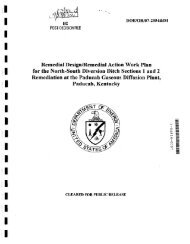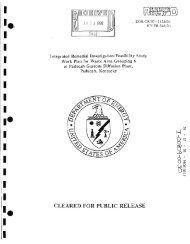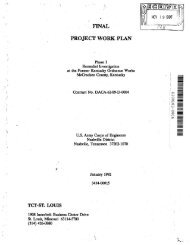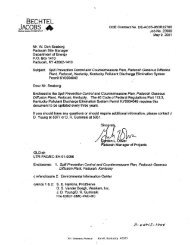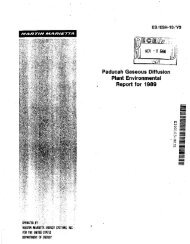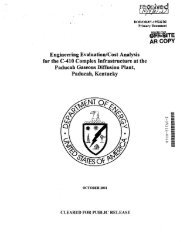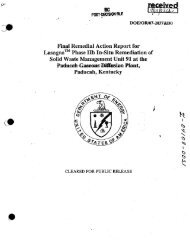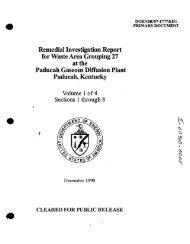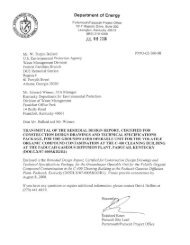1 - paducah environmental information center
1 - paducah environmental information center
1 - paducah environmental information center
Create successful ePaper yourself
Turn your PDF publications into a flip-book with our unique Google optimized e-Paper software.
Annual Site Environmental Report for 1999<br />
Table 2.2 Federally Listed, Proposed, and Candidate Species Potentially Occurring Within<br />
the Paducah Site Study Area in 1999a<br />
Common Name Scientific Name EndangeredSpecies Act Status<br />
Indiana Bat Myotis sodalis Listed Endangered<br />
Interior Least Tern Sterna antillarum athalassos Listed Endangered<br />
Pink Mucket Lampsilis abrupta Listed Endangered<br />
Ring Pink Obovaria retusa Listed Endangered<br />
Orange-footed Pearly Mussel Plethobasus cooperianus Listed Endangered<br />
Fat Pocketbook Potamilus capax Listed Endangered<br />
Tubercled-blossom Pearly Mussel Epioblasma torulosa torulosa Listed Endangered<br />
Bald Eagle Haliaeetus leucocephalus Listed Threatened<br />
Sturgeon Chub Macrhybopsis geUda Candidate<br />
Sicklefin Chub Macrhybopsis meeki Candidate<br />
a<br />
All of the above species are discussed in Environmentallnve.l'tigations at the Paducah<br />
Gaseous Diffusion Plant alld Surrounding Area, McCracken County, Kentucky, Volume<br />
Ill, U. S. Army Corps of Engineers Nashville District, May 1994. Note that the study<br />
area encompasses 11,719 acres and extends to include the Ohio River, which is over<br />
three miles north of the DOE reservation. None of these species has been reported as<br />
sighted on the DOE reservation although potential summer habitat exists there for the<br />
Indiana bat. No critical habitat for any of these species has been designated anywhere<br />
in the study area.<br />
In 1999, no floodplain or wetlands<br />
assessments were prepared or approved. Also,<br />
no floodplain or wetlands notices of involvement<br />
were published in the Federal Register for the<br />
Paducah Site. In addition; DOE did not apply for<br />
any individual permits from COE or for any<br />
water quality certifications from the state. Some<br />
DOE projects were authorized through the COE<br />
nationwide permit program for activities<br />
involving waters of the United States.<br />
DOE activities did not result in significant<br />
impacts to floodplains or wetlands at the<br />
Paducah Site in 1999.<br />
FloodplainlWetlands Environmental<br />
Review :Requirements NOVs<br />
No NOVs were received in 1999.<br />
Farm!and Protection Policy Act<br />
Prime farmland is generally defined as land<br />
that has the best combination of physical and<br />
chemical characteristics for producing crops of<br />
statewide or local importance. The Farmland<br />
Protection Policy Act of 1981 requires federal<br />
agencies to consider the effects of their proposed<br />
actions on prime farmland and consider any<br />
altemativesthat would lessen impacts. When<br />
required, ,prime farmland surveys are conducted,<br />
and DOE consults with the U. S. Department of<br />
Agriculture Natural Resources Conservation<br />
Service, formerly the Soil Conservation Service.<br />
If conversion of prime fannland is anticipated, a<br />
Farmland' Conversion Impact Rating form is<br />
completed and! submitted to the Natural<br />
Resources Conservation Service. No Farmland<br />
Conversion Impact Rating forms were submitted<br />
to the Natural Resources Conservation Service<br />
in 1999.<br />
Environmental Compliance<br />
2-9



